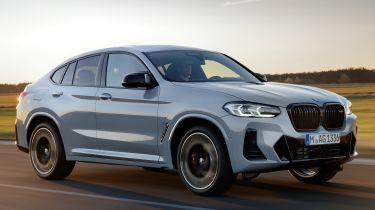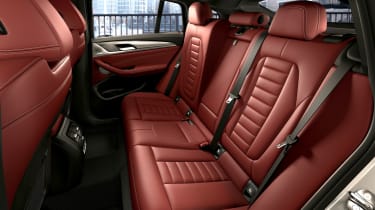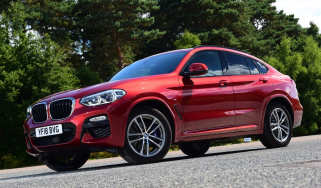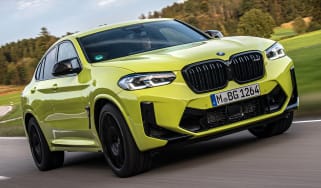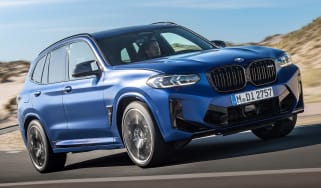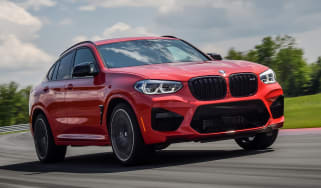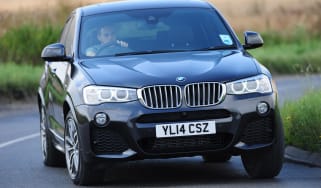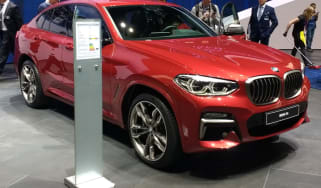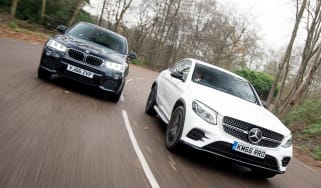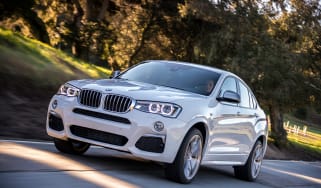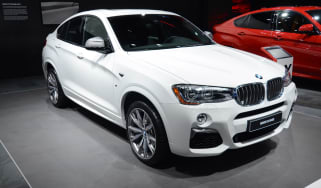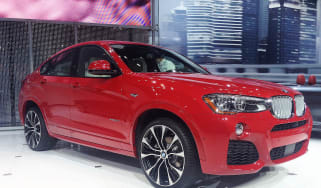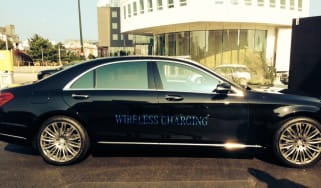BMW X4 review
The BMW X4 offers a little extra style over its X3 sibling, but it's more expensive and sacrifices practicality
It feels like a long time ago that the notion of a coupe/SUV crossover was seen as innovative, but having started this trend BMW isn’t backing away from it. The midsize X4 hits all the high notes of the X3, but then comes with a few added compromises impacted by its sloping roofline for the questionable benefit of aesthetics.
But regardless of its practical relevance, cars like the X4 just keep on selling, and compared to many rivals the BMW’s impressive powertrains and excellent build quality keep it near the top of the class, even if it’s now starting to look and feel a little dated.
About the BMW X4
The BMW X4 is currently in its second generation, and it follows a path that was defined by BMW when it first created the coupe SUV niche with its original X6. It did this by sloping the rear window to create a distinctive coupe (or hatchback) roofline atop a more traditional SUV body. As such, it’ll come as little surprise to find the X4 shares its basic chassis, powertrains and interior with the X3, with only mild tweaks to the ride and handling balance designed to give it a marginally ‘sportier’ feel.
A few rival manufacturers have gone down a similar route with their own takes on this very specific niche, with Mercedes recently revealing its second generation GLC Coupe and Audi also taking the bait with a Sportback version of its Q5. By contrast, other rivals have leaned into a sportier shape for a sole premium midsize SUV rather than creating a second derivative, including the Porsche Macan, Range Rover Velar and Jaguar F-Pace.
BMW facelifted the X4 in 2021, bringing with it new exterior styling elements, an upgraded interior and refreshed powertrains. It also slimmed the range down to just M Sport and M Performance models, all of which are comprehensively equipped.
At present the X4 is available with a choice of two petrol and three diesel engines. The entry-level four-cylinder xDrive20d is fitted with a 2.0-litre unit producing 187bhp, enough to deliver a 0-62mph time of 7.9 seconds. The xDrive30d gains two extra cylinders and a larger 3.0-litres capacity that yield added refinement and significantly more power, producing 282bhp and a 0-62mph time of 5.7 seconds.
M Performance models come in two flavours, petrol and diesel. The M40d uses an uprated version of the same six-cylinder diesel engine producing 335bhp for a rapid 0-62mph sprint of 4.9 seconds. Meanwhile the petrol-powered M40i comes with a twin-turbocharged six-cylinder engine which is good for 355bhp and the same 4.9 second 0-62mph time. All models are all-wheel drive and feature an eight-speed automatic transmission.
At the top of the range sits the X4 M Competition – an ultra high-performance version powered by a twin-turbocharged straight-six petrol engine with 503bhp and 600Nm of torque. This performance flagship is on another scale of pricing and performance, with unrelenting focus and an equally unrelenting driving experience.
How much does the BMW X4 cost?
Prices for basic X4s start from just over £50,000, with M Performance versions coming in at around £66,000 and the X4 M Competition costing nearly £94,000. This is a couple grand up on the equivalent X3 model, which come with similar equipment and performance.
Engines, performance and drive
A cornerstone of BMW models has always been their superb engineering. Engines, chassis and driver aid technology always seem to sync with total precision, creating a feeling of indomitable solidity and high-class eloquence. This is something that permeates with the X4 too, despite its contrived form.
Fundamentally the X4, and X3 on which it is based, feel very similar to drive. In its latest iteration, the X4 has only marginally retuned suspension to go with its wider rear track depending on the suspension option specified, but it would take back-to-back comparisons to notice any variation. The result is that the X4 handles with impressive composure without feeling too compromised.
Yet despite the sporty handling, the X4 is still a comfortable car with a caveat or two. All UK models are fitted as standard with M Sport suspension, and while being firm the ride is always composed and well-damped. Things can get a little choppy if you upsize the wheels to the 20- or 21-inch option, but the optional adaptive dampers then cancel this out as they have a further ‘comfort’ setting, making them a worthwhile upgrade. That gives the X4 the ability to cope with broken urban roads, motorways and challenging B-roads with general ease.
M Performance models have a bespoke suspension tune that certainly makes the cars feel more stable, but also compromise on low-speed ride – especially considering it runs a standard 21-inch wheel. The flipside is more agile handling, which makes better use of the rear-biased all-wheel drive system.
The eight-speed automatic transmission is excellent in the X4. It shifts smoothly and quickly, while the separate drive modes mean the gearbox is able to change its shift points that improves better response or economy depending on the selected mode. Manual shifting is also possible, either by the paddles on the back of the steering wheel or by using the gear selector, which retains a joystick-style lever rather than the tiny switch found in most modern BMWs.
The X4 M Competition is a totally different animal to lesser X4s, with a much more boisterous personality. Its suspension design isn’t fundamentally different, but the geometry and setup is completely bespoke, with much higher spring rates designed principally to keep the engine’s immense performance under control. The ride quality, even in its softest damper setting, is extremely firm creating a daily driving experience that’s more akin to a hardcore supermini than midsize SUV.
The flipside is that the X4 M Competition has very impressive dynamics, with a tail-happy demeanour that’s even more driver-focused than rivals from Porsche, Alfa Romeo or Maserati. As such it’s very engaging, but we’d suggest you drive it first to make sure you can live with the compromises that go with it.
0-62mph acceleration and top speed
The 181bhp 2.0-litre diesel found in the xDrive20d is the most popular choice here in the UK, and performs very well in a variety of circumstances. Although it’s not as quiet as an equivalent diesel engine found in an Audi Q5, it’s both faster and more efficient, while also syncing better with its eight-speed automatic transmission. On paper, it will do 0-62mph in 7.9 seconds.
Moving up to the xDrive30d brings the additional performance and sophistication of a six-cylinder 3.0-litre diesel unit, with the further benefit of it being significantly smoother than the four-cylinder diesel. It also turns the X4 into a bit of a high performance sleeper with a 0-62mph time of 5.7 seconds, yet only results in a small penalty in terms of increased fuel consumption. The M40d model is quicker still, with the twin-turbocharged unit pushing the X4 from 0-62mph in only 4.9 seconds, with a very generous slog of torque making it feel even more rapid in-gear than the numbers suggest.
The X4 engine line-up welcomed mild-hybrid technology in 2020, with the aim of improving fuel efficiency and CO2 emissions. It features on all diesel models and allows the X4 to coast with the engine off at speeds below 99mph. The system will also shut down the engine when slowing down below 9mph, allowing it to harvest electrical energy.
The M40i features BMW’s 352bhp twin-turbocharged 3.0-litre petrol unit which is found in everything from a 3 series, to a Toyota GR Supra, Morgan Plus Six and even the Ineos Grenadier. Its straight-six configuration helps keep the engine smooth even at high revs, but being a petrol, the engine’s less torquey than the equivalent M40d and is arguably less suited to the X4’s SUV body. So despite having more power than the diesel, its 0-62mph time only equals the M40d at 4.9 seconds, while using significantly more fuel in the process. It is lighter on its feet, though, making the M40i a sweeter drive in corners.
The X4 M Competition uses BMW M’s heavily upgraded S58 straight-six petrol that produces 503bhp. It might start life as the same engine as the one found in an M40i, but these are two very different animals, with a comprehensive overhaul that from the top down that include impressive high performance technologies like 3D printed elements in the headers and forged engine internals. Despite the two-tonne weight figure, the X4 M Competition will rocket to 62mph in 3.8 seconds and on to a limited top speed of 155mph, which can be raised to 177mph with the optional M Driver’s Pack fitted.
MPG, CO2 and running costs
Despite being a big and expensive SUV, the BMW X4’s impressive fuel economy keeps running costs down – although this is specific to the diesel-powered models. The entry-level xDrive20d model is capable of up to 49.6mpg on paper, although 45mpg is a figure that’s more likely to be expected in day-to-day driving.
The 3.0-litre diesel isn’t quite as frugal, although the differences are smaller than you’d expect. This comes courtesy not only of the inherent efficiency of BMW’s six-cylinder diesel, but the low-effort required to shift the X4’s mass in a majority of situations. As such, it can manage a claimed maximum of 45.6mpg, with real world figures not far off that figure. Emissions are quoted at 150g/km for the xDrive20d on its smallest available wheels, while the xDrive30d emits upwards of 163g/km of CO2.
The M40d’s takes another knock when it comes to figures, returning an average of 41.5mpg and emitting from 179g/km according to WLTP regulations, but the pay-off is very impressive performance that makes it a fantastic long-distance cruiser with very impressive in-gear acceleration.
Petrol models are predictably thirsty. The M40i has an official combined figure of up to 31.4mpg, although it’s tricky to crack 30mpg in real-world situations. The even hotter X4 M Competition drops this around 26mpg, but doing anything above 22mpg will be a good result in day-to-day driving.
What the fuel economy figures don’t tell you are the other running costs associated with driving such a big and heavy car. Tyres, brake pads and discs are all worked hard on cars like this, especially if you drive with some purpose. Models on bigger wheels obviously run on bigger tyres, and with a high-specification OEM fitment rubber like Michelin PS4s or high-end Continental ContiSport make replacement costs very high.
Insurance groups
The X4 xDrive20d M Sport model sits in group 33 for insurance which is broadly in line with its key rivals, but will result in above average premiums for most drivers and is also higher than the equivalent X3 model. The rest of the X4 range is rated between group 41 for the xDrive30d models, group 42 for the M40i and group 43 for the M40d, so insurance premiums will be a significant ongoing cost if you choose the higher-output models.
Depreciation
BMWs typically hold their value well compared to premium rivals, and the X4 is no exception, with an average of 55 per cent of its original value retained over a three-year/36,000-mile ownership period.
Interior, design and technology
The BMW X4 sets out to mix the design elements of an SUV with those of a coupe, and more than most cars only a potential owner can decide if it has been a success. The lower half of the body carries the bulk and toughness expected from an SUV, with the curved roofline of a coupe sitting on top of it.
Anyone looking for something more conventional should find the X3 to their liking, but at the very least the X4 offers distinction in a crowded vehicle segment. Underneath the X4 lies the same platform as used in the X3, with the only significant changes being a wider rear track to increase cornering ability.
A facelift in 2021 saw some cosmetic changes, with a new front end design incorporating slimmer LED headlights, a slightly larger kidney grille and a redesigned lower apron, while the rear features a new lower apron treatment and redesigned LED taillights with new light signatures
Inside the X4 is an unquestionable success, combining attractive design with quality materials to great effect. The interior is another element that is largely carried over from the X3, but in this instance that is good news; the layout is attractive but understated, easy to understand and adds to the sporty feel of the car. Where fitted, the leather is of a high quality, and the vast majority of the plastics in the cabin are soft and pleasing to touch.
Sat-nav, stereo and infotainment
Every X4 comes with a 12.3-inch central display running BMW’s iDrive 7 operating system. Whether you tap the screen or use the familiar iDrive rotary dial to control the system, it responds quickly and accurately, and the display offers clear and attractive graphics. BMW Professional Navigation, Apple CarPlay and Android Auto are all standard, while Gesture Control is available as an optional extra. The system allows you to use hand movements to make basic inputs, although this system is still relatively new and limited in its scope.
Practicality, comfort and boot space
Anyone choosing the X4 over the X3 is making a conscious decision to sacrifice some practicality in favour of a sportier drive and more dynamic-looking exterior. But even allowing for that, it still performs well in this department. The X4 is designed to seat four adults in comfort and can accommodate a fifth in a narrow seat for shorter journeys.
From the driver’s seat the view out is good, helped by the height of the body, although the view to the rear is somewhat reduced by the shallowness of the tailgate window. Oddment storage inside the cabin is impressive, with a generous glovebox, door pockets and a large central storage area between the seats. An optional extended storage pack is also available that adds features such as extra storage areas, 12v and USB sockets and the facility for securing loads in the boot.
Dimensions and size
At 4,752mm in length, the X4 is longer than both the Mercedes-Benz GLC Coupe and BMW X3, but only by a matter of 20mm in the case of the Mercedes. The same goes for height and width, but the differences between the X4 and X3 are more clear, with the former being longer, lower and wider than its stablemate despite riding on the same platform, with an identical wheelbase.
Leg room, head room & passenger space
Those sitting in the front are well catered for, with excellent head and legroom and a broad range of adjustment – supportive sports seats are fitted as standard on M Sport models. Those in the rear can also enjoy generous legroom; sufficient to sit taller adults in the rear. Where the X4 lags behind the X3 is in rear headroom, with those of six feet in height likely to find their heads making contact with the roof lining. The centre rear seat is also best used for shorter journeys, as it is narrower and lacks any kind of side bolstering, and the transmission tunnel eats into legroom for the central passenger.
Boot space
From the outside it is hard to believe that the X4 offers much luggage space, but there’s 525 litres with the rear seats in place, and up to 1,430 litres with them folded. The rear bench can be split 40:20:40 for maximum flexibility and the powered tailgate is also a useful addition. In terms of volume the X4 is close to offering the load capacity of the X3, but the shape of the tailgate and the steeply-raked window means bulkier items will not fit and loading the vehicle is more of a challenge thanks to the smaller aperture.
Towing
The X4 can be specified with a towing package which includes an electrically folding tow bar and the addition of trailer stability control to the standard Dynamic Stability Control system. The maximum trailer load is 2,000kg depending on the engine, and although those wishing to tow might choose a different BMW model, it may be a useful option for some.
Reliability and safety
As the X4 is likely to be used as a family car, safety remains a priority, and this is reflected in the generous provision of safety systems. Autonomous emergency braking (AEB) is fitted as standard across the range, and this can be supplemented with the optional fitment of active cruise control and lane-keeping assistance.
The optional Dynamic Safety system adds pre-emptive safety measures such as tightening the seatbelts if it determines that a crash is imminent, and can apply the brakes if an accident occurs. Euro NCAP produced an assessment of both the X3 and X4 in 2017, awarding both its maximum five-star rating.
The X4 didn't feature in our most recent Driver Power customer satisfaction survey, while BMW itself came 21st in the best car manufacturers rankings – down from 16th in 2022. BMW owners who took part in the survey have said their cars could be more reliable, and are quite expensive to run and maintain.
Warranty
The BMW X4 comes with a three-year warranty, with no mileage limit for that period. Mercedes offers identical levels of coverage for its cars, while all new Audis get a three-year/60,000-mile factory warranty.
Servicing
Another significant factor in running costs of the X4 will be servicing and parts replacement, although the BMW Pay Monthly Service Plan allows you to spread the cost of scheduled maintenance.

